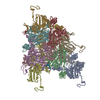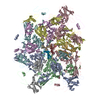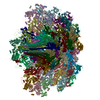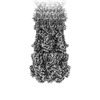+ Open data
Open data
- Basic information
Basic information
| Entry |  | |||||||||
|---|---|---|---|---|---|---|---|---|---|---|
| Title | Tip section. | |||||||||
 Map data Map data | ||||||||||
 Sample Sample |
| |||||||||
 Keywords Keywords | crAssphage / bacteriophage / virus / DNA virus / tail / muzzle | |||||||||
| Function / homology | virus tail / virion component / Ring protein 4/5 / Muzzle protein Function and homology information Function and homology information | |||||||||
| Biological species |  Bacteroides phage crAss001 (virus) Bacteroides phage crAss001 (virus) | |||||||||
| Method | single particle reconstruction / cryo EM / Resolution: 3.38 Å | |||||||||
 Authors Authors | Bayfield OW / Shkoporov AN / Yutin N / Khokhlova EV / Smith JLR / Hawkins DEDP / Koonin EV / Hill C / Antson AA | |||||||||
| Funding support |  United Kingdom, 1 items United Kingdom, 1 items
| |||||||||
 Citation Citation |  Journal: Nature / Year: 2023 Journal: Nature / Year: 2023Title: Structural atlas of a human gut crassvirus. Authors: Oliver W Bayfield / Andrey N Shkoporov / Natalya Yutin / Ekaterina V Khokhlova / Jake L R Smith / Dorothy E D P Hawkins / Eugene V Koonin / Colin Hill / Alfred A Antson /    Abstract: CrAssphage and related viruses of the order Crassvirales (hereafter referred to as crassviruses) were originally discovered by cross-assembly of metagenomic sequences. They are the most abundant ...CrAssphage and related viruses of the order Crassvirales (hereafter referred to as crassviruses) were originally discovered by cross-assembly of metagenomic sequences. They are the most abundant viruses in the human gut, are found in the majority of individual gut viromes, and account for up to 95% of the viral sequences in some individuals. Crassviruses are likely to have major roles in shaping the composition and functionality of the human microbiome, but the structures and roles of most of the virally encoded proteins are unknown, with only generic predictions resulting from bioinformatic analyses. Here we present a cryo-electron microscopy reconstruction of Bacteroides intestinalis virus ΦcrAss001, providing the structural basis for the functional assignment of most of its virion proteins. The muzzle protein forms an assembly about 1 MDa in size at the end of the tail and exhibits a previously unknown fold that we designate the 'crass fold', that is likely to serve as a gatekeeper that controls the ejection of cargos. In addition to packing the approximately 103 kb of virus DNA, the ΦcrAss001 virion has extensive storage space for virally encoded cargo proteins in the capsid and, unusually, within the tail. One of the cargo proteins is present in both the capsid and the tail, suggesting a general mechanism for protein ejection, which involves partial unfolding of proteins during their extrusion through the tail. These findings provide a structural basis for understanding the mechanisms of assembly and infection of these highly abundant crassviruses. #1:  Journal: Res Sq / Year: 2023 Journal: Res Sq / Year: 2023Title: Structural atlas of the most abundant human gut virus Authors: Antson A / Bayfield O / Shkoporov A / Yutin N / Khokhlova E / Smith J / Hawkins D / Koonin E / Hill C | |||||||||
| History |
|
- Structure visualization
Structure visualization
| Supplemental images |
|---|
- Downloads & links
Downloads & links
-EMDB archive
| Map data |  emd_14093.map.gz emd_14093.map.gz | 51.7 MB |  EMDB map data format EMDB map data format | |
|---|---|---|---|---|
| Header (meta data) |  emd-14093-v30.xml emd-14093-v30.xml emd-14093.xml emd-14093.xml | 18.7 KB 18.7 KB | Display Display |  EMDB header EMDB header |
| FSC (resolution estimation) |  emd_14093_fsc.xml emd_14093_fsc.xml | 10.1 KB | Display |  FSC data file FSC data file |
| Images |  emd_14093.png emd_14093.png | 95.7 KB | ||
| Filedesc metadata |  emd-14093.cif.gz emd-14093.cif.gz | 6.3 KB | ||
| Others |  emd_14093_additional_1.map.gz emd_14093_additional_1.map.gz emd_14093_additional_2.map.gz emd_14093_additional_2.map.gz | 83.1 MB 13.2 MB | ||
| Archive directory |  http://ftp.pdbj.org/pub/emdb/structures/EMD-14093 http://ftp.pdbj.org/pub/emdb/structures/EMD-14093 ftp://ftp.pdbj.org/pub/emdb/structures/EMD-14093 ftp://ftp.pdbj.org/pub/emdb/structures/EMD-14093 | HTTPS FTP |
-Validation report
| Summary document |  emd_14093_validation.pdf.gz emd_14093_validation.pdf.gz | 505.7 KB | Display |  EMDB validaton report EMDB validaton report |
|---|---|---|---|---|
| Full document |  emd_14093_full_validation.pdf.gz emd_14093_full_validation.pdf.gz | 505.3 KB | Display | |
| Data in XML |  emd_14093_validation.xml.gz emd_14093_validation.xml.gz | 11.6 KB | Display | |
| Data in CIF |  emd_14093_validation.cif.gz emd_14093_validation.cif.gz | 15 KB | Display | |
| Arichive directory |  https://ftp.pdbj.org/pub/emdb/validation_reports/EMD-14093 https://ftp.pdbj.org/pub/emdb/validation_reports/EMD-14093 ftp://ftp.pdbj.org/pub/emdb/validation_reports/EMD-14093 ftp://ftp.pdbj.org/pub/emdb/validation_reports/EMD-14093 | HTTPS FTP |
-Related structure data
| Related structure data |  7qokMC  7qofC  7qogC  7qohC  7qoiC  7qojC  7qolC M: atomic model generated by this map C: citing same article ( |
|---|---|
| Similar structure data | Similarity search - Function & homology  F&H Search F&H Search |
- Links
Links
| EMDB pages |  EMDB (EBI/PDBe) / EMDB (EBI/PDBe) /  EMDataResource EMDataResource |
|---|
- Map
Map
| File |  Download / File: emd_14093.map.gz / Format: CCP4 / Size: 89.2 MB / Type: IMAGE STORED AS FLOATING POINT NUMBER (4 BYTES) Download / File: emd_14093.map.gz / Format: CCP4 / Size: 89.2 MB / Type: IMAGE STORED AS FLOATING POINT NUMBER (4 BYTES) | ||||||||||||||||||||||||||||||||||||
|---|---|---|---|---|---|---|---|---|---|---|---|---|---|---|---|---|---|---|---|---|---|---|---|---|---|---|---|---|---|---|---|---|---|---|---|---|---|
| Projections & slices | Image control
Images are generated by Spider. | ||||||||||||||||||||||||||||||||||||
| Voxel size | X=Y=Z: 1.3941 Å | ||||||||||||||||||||||||||||||||||||
| Density |
| ||||||||||||||||||||||||||||||||||||
| Symmetry | Space group: 1 | ||||||||||||||||||||||||||||||||||||
| Details | EMDB XML:
|
-Supplemental data
-Additional map: #1
| File | emd_14093_additional_1.map | ||||||||||||
|---|---|---|---|---|---|---|---|---|---|---|---|---|---|
| Projections & Slices |
| ||||||||||||
| Density Histograms |
-Additional map: #2
| File | emd_14093_additional_2.map | ||||||||||||
|---|---|---|---|---|---|---|---|---|---|---|---|---|---|
| Projections & Slices |
| ||||||||||||
| Density Histograms |
- Sample components
Sample components
-Entire : Bacteroides phage crAss001
| Entire | Name:  Bacteroides phage crAss001 (virus) Bacteroides phage crAss001 (virus) |
|---|---|
| Components |
|
-Supramolecule #1: Bacteroides phage crAss001
| Supramolecule | Name: Bacteroides phage crAss001 / type: virus / ID: 1 / Parent: 0 / Macromolecule list: #1-#3 / NCBI-ID: 2301731 / Sci species name: Bacteroides phage crAss001 / Virus type: VIRION / Virus isolate: SPECIES / Virus enveloped: No / Virus empty: No |
|---|
-Macromolecule #1: Muzzle protein gp44
| Macromolecule | Name: Muzzle protein gp44 / type: protein_or_peptide / ID: 1 / Number of copies: 1 / Enantiomer: LEVO |
|---|---|
| Source (natural) | Organism:  Bacteroides phage crAss001 (virus) Bacteroides phage crAss001 (virus) |
| Molecular weight | Theoretical: 156.459312 KDa |
| Sequence | String: MALKKEQHFF KGMQRDLSVS KFNPEYAFDA QNIRITAREH DTLLSVSNEK GNKEIPLQSP SGDPVVIDGV LLGQNVLNNY VTLFTKGTN DNIYRLENKG TYFETLILFS GNLNFSTDYP IESISVYENN NIQKVYWVDG LNQARVINIT KDDYNNADDF D FVGTIHTS ...String: MALKKEQHFF KGMQRDLSVS KFNPEYAFDA QNIRITAREH DTLLSVSNEK GNKEIPLQSP SGDPVVIDGV LLGQNVLNNY VTLFTKGTN DNIYRLENKG TYFETLILFS GNLNFSTDYP IESISVYENN NIQKVYWVDG LNQARVINIT KDDYNNADDF D FVGTIHTS SKIEVSKVNG SGAFGQGVIQ YAFTYYNKYG KETNIFRTSP LLYIAYSDRG ASPEETVSCS FQINFTELDS SY DFIRVYS IHRTSIDATP TVRKVADLAT DTKLYVDTGT TGEIVDPTLL LYVGGEEIAP YTMTQKDNTL FLGNYTLKRS LIS TELKNQ IKSDSIVTTI LGGLDDAIES EWNVNTQYNS NYDLNYDSRI KGFQKGEIYR LGIQFQDNKG KWSEVVFIGD YECT ERFKY TQYDTYGITL IPRFKVVISN STTIQAIKNL GYINARGVVV FPTLEDRNIL CQGILCPTVA NYKDRLDNSP FVQSS WFSR PKQATETWKT EYSGTNHLSE FGEVPYFQHN EPIGSASLSE ITRWEIQTSL GLVPYYNPST TNAKDFVDGS PSEFLV DEN IVTMHSPDVE FDDRLQNITN GKFKLRIIGT THLTNTLSDI SVITSTPTYG NYATGFYKGK VANMNISTSY YGGRQLS AG LFWSDNVKFQ DPSPQDKLER LWMVYPWHRN GSLMNMGVPT EGTRAAALQR KIISNLKFAS QNNYLPNQSV WEAEISGD A NHTGITPVNS WTEGLVRIPA QANSNLGSLN YYANIDKVLT FNRSEQISEI YKNGYLIYTT KDWITDGKIA DLFNNAISQ TISVDQVQDW LTRIADTDKY GTEPVSMKYK SNPHLVFAFN YTESGKQLIL PMKNNNNGYL APSANSKPFW NPTAPEGAVY QDSINFTNE NRAFFWLAEL YRDSVVNRFG GDTEEAILNN TWLPSGDSVI IGDSINIEYT EGDTYYQRYD CLRTFAYTNE D QNSIVDIV SFMCESKVNI DGRYDKNRGQ VNNLAVSPTN FNLFNPVYSQ KNNFFTFRTI DYERFSINYF PNSITVTKEK SL GEDIDTW TNITLATTLD LDGDKGEIVS LNTYNNEIFC FQRRGLSNIL FNSRVQIPTS DGMPIEITNG LKVSGKRYIS NTI GCANKW SIAESPSGLY FIDNETNSLY LFNGEIVSLS DKLGFRQWIS THNVHVNWEP VGYNNYRSFY DKNNNDVYFT YKDH CLCYS ELINQFTSFM SYEGVPAMFN VSSEFYAFKD GKMWEQFAGD YNMFFGEYKP FSITFVANAE EPNDKIFNTV EFRAD SWDS DNLISNKTFD TLDVWNEYQH GTTPLTNLLG HPSPLKKKFR IWRANIPRAI ANNRDRIRNT WAYIKLGMNT PNTYRT EFH DAIIHYFA UniProtKB: Muzzle protein |
-Macromolecule #2: Muzzle bound helix
| Macromolecule | Name: Muzzle bound helix / type: protein_or_peptide / ID: 2 / Number of copies: 1 / Enantiomer: LEVO |
|---|---|
| Source (natural) | Organism:  Bacteroides phage crAss001 (virus) Bacteroides phage crAss001 (virus) |
| Molecular weight | Theoretical: 1.209482 KDa |
| Sequence | String: (UNK)(UNK)(UNK)(UNK)(UNK)(UNK)(UNK)(UNK)(UNK)(UNK) (UNK)(UNK)(UNK)(UNK) |
-Macromolecule #3: Ring protein 4/5 gp34
| Macromolecule | Name: Ring protein 4/5 gp34 / type: protein_or_peptide / ID: 3 / Number of copies: 2 / Enantiomer: LEVO |
|---|---|
| Source (natural) | Organism:  Bacteroides phage crAss001 (virus) Bacteroides phage crAss001 (virus) |
| Molecular weight | Theoretical: 26.680965 KDa |
| Sequence | String: MNVNEFSNEF DVLYNNIMSN AAPGLNEYEK SVLLTKAQEE IVKNYFEPAG NKYGKGLDDS PKRQIDFSEL IKVGEGVLNT SAPTITFDK RAKVYDLPAD LFLVINEAVD TNAGTKQIVP ISYSDYTRLM SRPYKEPVKY QAWRIITTSI NNISVELIVN S NETITDYK ...String: MNVNEFSNEF DVLYNNIMSN AAPGLNEYEK SVLLTKAQEE IVKNYFEPAG NKYGKGLDDS PKRQIDFSEL IKVGEGVLNT SAPTITFDK RAKVYDLPAD LFLVINEAVD TNAGTKQIVP ISYSDYTRLM SRPYKEPVKY QAWRIITTSI NNISVELIVN S NETITDYK VRYIRRPAPI ITTNLSSEYG DVTINGVSTV SECELNPIIH SEILQRAVEL AKAAYQGDLQ ASVELGQRSE UniProtKB: Ring protein 4/5 |
-Macromolecule #4: MAGNESIUM ION
| Macromolecule | Name: MAGNESIUM ION / type: ligand / ID: 4 / Number of copies: 1 / Formula: MG |
|---|---|
| Molecular weight | Theoretical: 24.305 Da |
-Experimental details
-Structure determination
| Method | cryo EM |
|---|---|
 Processing Processing | single particle reconstruction |
| Aggregation state | particle |
- Sample preparation
Sample preparation
| Buffer | pH: 7.5 |
|---|---|
| Vitrification | Cryogen name: ETHANE |
- Electron microscopy
Electron microscopy
| Microscope | FEI TITAN KRIOS |
|---|---|
| Image recording | Film or detector model: FEI FALCON III (4k x 4k) / Detector mode: INTEGRATING / Average electron dose: 51.0 e/Å2 |
| Electron beam | Acceleration voltage: 300 kV / Electron source:  FIELD EMISSION GUN FIELD EMISSION GUN |
| Electron optics | Illumination mode: FLOOD BEAM / Imaging mode: BRIGHT FIELD / Nominal defocus max: 1.5 µm / Nominal defocus min: 0.3 µm |
| Experimental equipment |  Model: Titan Krios / Image courtesy: FEI Company |
+ Image processing
Image processing
-Atomic model buiding 1
| Refinement | Space: REAL / Protocol: AB INITIO MODEL / Overall B value: 180 |
|---|---|
| Output model |  PDB-7qok: |
 Movie
Movie Controller
Controller











 Z (Sec.)
Z (Sec.) Y (Row.)
Y (Row.) X (Col.)
X (Col.)





































